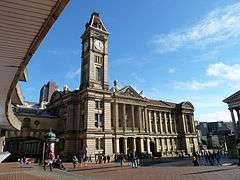Staffordshire Hoard
The Staffordshire Hoard is the largest hoard of Anglo-Saxon gold and silver metalwork yet found. It consists of over 3,500 items, amounting to a total of 5.1 kg (11 lb) of gold, 1.4 kg (3 lb) of silver and some 3,500 pieces of garnet cloisonné jewellery.[1]
| Staffordshire Hoard | |
|---|---|
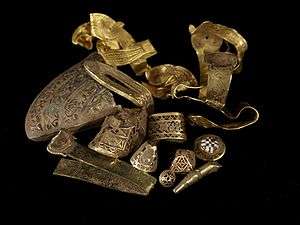 | |
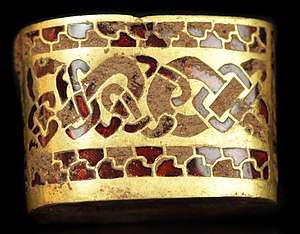 | |
| Material |
|
| Size | over 3,500 items |
| Writing | Latin |
| Created | c. 7th to 8th centuries |
| Discovered | 2009 Hammerwich near Lichfield, Staffordshire, England 52°39′19″N 1°54′24″W |
| Discovered by | Terry Herbert |
| Present location | |
The hoard was most likely deposited in the 7th century, and contains artefacts probably manufactured during the 6th and 7th centuries.[2] It was discovered in 2009 in a field near the village of Hammerwich, near Lichfield, in Staffordshire, England. The location was in the Anglo-Saxon kingdom of Mercia at the time of the hoard's deposition.
The hoard is of "radical" importance in Anglo-Saxon archaeology.[3][4] The artefacts are nearly all martial in character and contain no objects specific to female uses.[5][6] The average quality of the workmanship is extremely high and especially remarkable in view of the large number of individual objects, such as swords and a helmet, from which many of the fragments in the hoard came.
The hoard was purchased jointly by the Birmingham Museum and Art Gallery and the Potteries Museum & Art Gallery for £3.285 million under the Treasure Act 1996.
Contents
The hoard includes 3,490 metal fragments,[1] totalling 5.094 kg (11.23 lb) of gold and 1.442 kg (3.18 lb) of silver, with 3,500 cloisonné garnets[5][7] and is the largest treasure of Anglo-Saxon gold and silver objects discovered to date, eclipsing, at least in quantity, the 1.5 kg (3.3 lb) hoard found in the Sutton Hoo ship burial in 1939.[8]
Apart from three religious objects the items in the hoard are military,[5] and there are no domestic objects, such as vessels or eating utensils, or feminine jewellery, which are the more common Anglo-Saxon gold finds. Reportedly, the contents "show every sign of being carefully selected".[9] There is broad agreement that the typical object in the hoard was made in the 7th century, with the date of the deposition of the hoard of course post-dating the manufacture of the latest object it includes.
Along with other discoveries, examination of the hoard showed Saxon goldsmiths were able to alter the surface of the gold by depletion gilding to give the appearance of a higher gold content, a technique not previously credited to them.[10] As with other Anglo-Saxon jewellery, the garnets in 28 pieces may have come from as far away as Sri Lanka or Afghanistan, probably in the Roman period.[11][12]
A summary of the preliminary contents of the hoard, as of late 2009, is shown in the table below. This excludes items such as the gold horse's head that were in one of the 33 soil blocks that had not been examined at the time of publication of these figures.
| Description | Gold | Silver | Base metal | Composite metals | Stone or glass | Uncertain | Total |
|---|---|---|---|---|---|---|---|
| Appliqué | 1 | 1 | |||||
| Bead | 1 | 1 | |||||
| Boss | 6 | 1 | 7 | ||||
| Brooch | 1 | 1 | |||||
| Buckle and plate | 2 | 2 | |||||
| Button | 1 | 1 | |||||
| Cross | 5 | 5 | |||||
| Dome | 1 | 1 | |||||
| Edging | 11 | 69 | 6 | 1 | 87 | ||
| Fish | 1 | 1 | |||||
| Fitting | 35 | 11 | 3 | 4 | 53 | ||
| Foil | 16 | 16 | |||||
| Fragment | 79 | 177 | 29 | 19 | 4 | 7 | 315 |
| Garnet | 26 | 26 | |||||
| Glass gem | 1 | 1 | |||||
| Mount | 15 | 4 | 19 | ||||
| Panel | 3 | 3 | |||||
| Pin | 2 | 5 | 7 | ||||
| Plate | 58 | 13 | 1 | 1 | 1 | 74 | |
| Ring | 12 | 1 | 13 | ||||
| Rivet | 27 | 29 | 5 | 4 | 65 | ||
| Setting | 2 | 1 | 3 | ||||
| Sheet metal | 36 | 233 | 12 | 3 | 2 | 286 | |
| Slag | 2 | 2 | |||||
| Snake | 5 | 5 | |||||
| Spillage | 1 | 1 | |||||
| Stone | 1 | 1 | |||||
| Strip | 94 | 102 | 5 | 1 | 1 | 203 | |
| Stud | 9 | 3 | 1 | 13 | |||
| Sword hilt plate or fitting | 178 | 29 | 8 | 1 | 1 | 217 | |
| Sword pommel | 69 | 10 | 5 | 2 | 86 | ||
| Sword pyramid | 8 | 1 | 1 | 10 | |||
| Sword scabbard loop | 1 | 1 | |||||
| Wire | 34 | 13 | 1 | 1 | 49 | ||
| Unidentified | 2 | 4 | 1 | 2 | 1 | 8 | 18 |
| Total | 712 | 707 | 78 | 39 | 36 | 22 | 1,594 |
Weaponry
.jpg)
The contents include many finely worked silver and gold sword decorations removed from weaponry, including 66 gold sword hilt collars and many gold hilt plates, some with inlays[9] of cloisonné garnet in zoomorphic designs (see lead picture).[14] The 86 sword pommels found constitute the largest ever discovery of pommels in a single context, with many different types (some previously unknown) supporting the idea that the pommels were manufactured over a wide range of time.[15]
Crosses
The Staffordshire Hoard official press statement notes that the only items in the hoard that are obviously non-martial are two (or possibly three) crosses. Sharp (2016) has shown there are possibly many pieces with a Christian connection and the hoard is a mixture of many Christian and non-martial items. The largest of the three crosses is missing some decorative settings (yet some are present but detached) but otherwise remains intact. It may have been an altar or processional cross. It could also have been attached to the front of a book, such as a Gospel Book. Yet the cross is folded. As to the reason or reasons for this, three explanations have been put forward. One is that the folding was done prior to burial "to make it fit into a small space". A second explanation suggests that this is a sign that the burial deposit was made by pagans, who had no particular esteem for the Christian character of the objects. A third view runs in an opposite direction, namely, that this was done with reverence by Christians in order to remove the sacred character of this cross, and other Christian pieces, prior to burying them.[16] A gold and garnet fitting, made for the corner of a flat rectangular object, may be for the corner of a book-cover, which in this context would almost certainly have been a Gospel Book.
Gold strip

One of the most intriguing items in the hoard is a small strip of gold (StH 550), measuring 179 mm × 15.8 mm × 2.1 mm (7.047 in × 0.622 in × 0.083 in) when unfolded, inscribed with a biblical quotation, from Numbers 10:35, in insular majuscule, on both sides, as
- [S]URGE:DNE:DISEPENTURINIMICITUIE/T | [F]UGENT QUIODERUNTTEAFACIETUA (outside)
- SURGE DNE DISEPINTUR [...MIC]ITUIE/TFUGIU[N/T]QUIO DE | [R]UNTTE AF ACIE TU[..]DIUIE NOS[.R.] (inside)
The Nova Vulgata reading of this passage is: Surge Domine et dissipentur inimici tui et fugiant qui oderunt te a facie tua (KJV: "Rise up, LORD, and let thine enemies be scattered; and let them that hate thee flee before thee.") The reading of the additional words on the second version of the text, [a]diuie nos[.r.], is unclear; they may be practice letters, meaning that the inside face was not supposed to be visible and contains an abandoned attempt at the inscription.[17]
The passage is quoted fairly often, notably in the Life of the Mercian Saint Guthlac (d. 714), most likely composed in the 730s. The passage occurs in the context of Guthlac's meeting with Æthelbald, the later king of Mercia, in which the saint foretells that the king's enemy would "flee from your face". The parallel verse from Psalm 67 (Hebrew numbering 68), verse 2, occurs when Guthlac is driving away demons who appeared to him in a vision.[17] Sharp (2016) has suggested the inscription shows angst in the face of a great threat and this could only have been the Viking invasion. The incised strip appears to be the stem of a cross and this indicates a Viking threat to a church. Paleographically, the inscription most likely dates to the 8th century, with the late 7th or early 9th not to be ruled out. The closest parallel to the script used is the inscription in the lead plate from Flixborough, dated to the 8th or 9th century.[17]
The gold strip may have been originally fastened to a shield or a sword belt,[18] or alternatively, it may have been part of the arm of a cross; a round cabochon jewel would have been fitted to the terminal end, and the other end would have fitted into the central fitting of the cross.[19]
Context and purpose
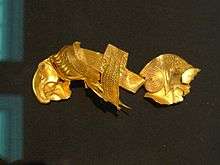
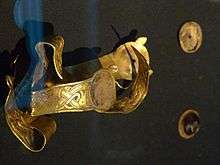
The hoard was deposited in a remote area, just south of the Roman Watling Street, some 4 kilometres (2 mi) west of Letocetum, at the time part of the extra-parochial area of Ogley Hay (now part of the Hammerwich parish), in the highland separating the Pencersæte and Tomsæte within the kingdom of Mercia.[20]
The quality of the artefacts buried in the hoard is very high. The apparent selection of "martial" artefacts, especially the decoration of swords, does not suggest that the hoard consists simply of loot. Most of the gold and silver items appear to have been intentionally removed from the objects they were previously attached to. Brooks (2010) associates the predominantly warlike character of the artefacts in the hoard with the custom of giving war-gear (heriot) as death duty to the king upon the death of one of his noblemen.[21] The removal of the sword pommel caps finds a parallel in Beowulf which mentions warriors stripping the pommels of their enemies' swords.[22]
Wall (2015) postulates a connection to Peada, briefly king of Mercia in 655/6.[23] Sharp (2016) connects the deposition of the Hoard with the Viking attack on Lichfield in 875 and postulates its loss at the same time as the removal of the St Chad's Gospel from Lichfield into the Welsh area of Mercia.
Discovery and excavation
Gold artefacts were discovered by Terry Herbert on 5 July 2009, when he was searching an area of recently ploughed farmland near Hammerwich, Staffordshire, with a metal detector.[24] Over the next five days,[25] 244 gold objects were recovered from the soil. At this point Herbert contacted Duncan Slarke, the Finds Liaison Officer for the Staffordshire and West Midlands Portable Antiquities Scheme.[26][27] The landowner, Fred Johnson, granted permission for an excavation to search for the rest of the hoard.[27]
2009 excavation
Excavation work was funded by English Heritage who contracted Birmingham Archaeology to do the fieldwork. Ploughing had scattered the artefacts, so an area 9 by 13 metres (30 by 43 ft) was excavated in the search.[28] Because of the importance of the find, the exact site of the hoard was initially kept secret.[8] A geophysical survey of the field in which the hoard was found discovered what could be a ditch close to the find. Although excavations revealed no dating evidence for the feature, further investigation is planned. In total over 3,500 pieces were recovered.[1] A final geophysical survey using specialist equipment provided by the Home Office did not suggest any further artefacts remained to be found.[29]
.jpg)
The discovery was publicly announced on 24 September 2009, attracting worldwide attention. An official website set up to showcase finds from the Hoard received over 10 million views in the first week after the announcement. Whilst Birmingham Archaeology continued to process the find, items from the Hoard were displayed at the Birmingham Museum and Art Gallery until 13 October 2009, attracting 40,000 people.[30][31] Andrew Haigh, the coroner for South Staffordshire, declared the hoard to be treasure,[30] and therefore property of the Crown. A further selection of pieces from the Hoard was displayed at the Potteries Museum & Art Gallery, Stoke-on-Trent. Key items and numerous smaller pieces were then taken to the British Museum, London, where cataloguing, and some initial cleaning and conservation work commenced.
As of 24 September 2009, 1,381 objects had been recovered, of which 864 have a mass of less than 3 grams (0.096 ozt), 507 less than 1 gram (0.032 ozt), leaving just 10 larger items. X-rays of unexamined lumps of earth suggest that there are more to be revealed. Early analysis established that the hoard was not associated with a burial.[9]
2010 excavation
In late March 2010, a team of archaeologists carried out a follow-up excavation on the site, digging 100 metres (110 yd) of trenches and pits in the field. According to Staffordshire county archaeologist Stephen Dean, there is no more gold or treasure to recover from the site, and the aim of the new excavation is to look for dating and environmental evidence. Archaeologists hope to be able to use this evidence to determine what the landscape looked like at the time that the hoard was deposited.[32]
2012 finds
In December 2012, it was announced that 91 additional items of gold and silver metalwork had been found in the field where the Staffordshire Hoard was discovered in 2009. The finds were made in November 2012 when archaeologists and metal detectorists from Archaeology Warwickshire, working for Staffordshire County Council and English Heritage, visited the field after it had been ploughed. Many of the pieces are less than 1 gram (0.032 ozt) in weight, but there are some larger pieces, including a cross-shaped mount, an eagle-shaped mount, and a helmet cheek piece that matches one from the 2009 discovery. These additional pieces are believed to be part of the original hoard.[33][34][35]
In January 2013, 81 of the 91 items were declared treasure at a coroner's inquest, and, after they have been valued by the Treasure Valuation Committee, Staffordshire County Council will have an opportunity to purchase the items so that they can be reunited with the rest of the hoard. Although these items were found by archaeologists, the money raised by their sale will be shared between Herbert and Johnson as they were responsible for the original discovery of the hoard. The ten items not declared treasure were identified as modern waste material.[36][37]
Kevin Leahy of the British Museum has stated that the ten items not declared as belonging to the original hoard may represent part of a different Anglo-Saxon period hoard. Two of these ten items are high-quality pieces of copper alloy, but they are different in style to the gold and silver items of the original hoard. He concludes that "Anglo Saxons clearly visited the site more than once to bury items".[38]
Valuation and sale
_and_Caroline_Lyons_(Treasure_Team).jpg)
On 25 November 2009, the hoard was valued by the Treasure Valuation Committee at £3.285 million, which, under the provisions of the 1996 Treasure Act, is the sum that must be paid as a reward to the finder and landowner, to be shared equally, by any museum that wishes to acquire the hoard.[39][40]
After the hoard was valued, it was announced that the Birmingham Museum and Art Gallery and the Potteries Museum & Art Gallery intended to acquire the entire hoard jointly, and a public appeal was launched to raise the £3.285 million needed to purchase the hoard. The Art Fund co-ordinated the appeal. If the sum had not been raised by 17 April 2010, the Hoard might have been sold on the open market and the unique collection permanently broken up.[41] On 23 March 2010 it was announced that the sum had been raised three weeks before the deadline, after a grant of £1.285 million from the National Heritage Memorial Fund (NHMF) was added to the money already collected from individuals, councils, and other groups and associations.[42] Although the purchase price has been achieved, the Art Fund appeal is still continuing, in order to raise a further £1.7 million to help fund the conservation, study and display of the hoard.[42]
Terry Herbert, the finder of the hoard, and Fred Johnson, the farmer on whose land the hoard was found, each received a half share of the £3.285 million raised by the Birmingham Museum & Art Gallery and the Potteries Museum & Art Gallery.[43] The two men were later reported to have "fallen out" over the division of the money.[44][45]
Display
The hoard was first displayed at the Birmingham Museum and Art Gallery (from 24 September 2009 until 13 October 2009), and subsequently part of the hoard was put on display at the British Museum (from 3 November 2009 until 17 April 2010). Eighty items from the hoard, including a gold horse's head that has not previously been exhibited, went on display at the Potteries Museum & Art Gallery in Stoke-on-Trent from 13 February 2010 until 7 March 2010.[46] Items from the hoard were on display at the National Geographic Museum in Washington, DC, United States, from 29 October 2011 to 4 March 2012.[47][48] Birmingham Museum has had a permanent gallery dedicated to the hoard since 2014, and the Potteries Museum has a hoard exhibition, and there are regular loans made to historic Mercian sites Tamworth Castle and Lichfield Cathedral, as part of the Mercian Trail.[49][50] Two replicas of the helmet have been made for display in the museums in Birmingham and Stoke.[51]
On 26 January 2012, the hoard was featured in the hour-long BBC Two documentary Saxon Hoard: A Golden Discovery presented by TV historian Dan Snow.[52] A similar show, titled "Secrets of the Saxon Gold", was aired on 22 April 2012 as a Time Team special and presented by Tony Robinson.
In 2016, weapon fittings from the hoard went on a national tour of the UK, Warrior Treasures: Saxon Gold from the Staffordshire Hoard, to the Royal Armouries, Leeds (May–October) and Bristol Museum and Art Gallery (October 2016 – April 2017).
In 2020, part the hoard was to be displayed at the National Trust's Sutton Hoo visitor centre, alongside items usually on display in the British Museum,[53] running from May to November,[54] but was disrupted by Covid-19.
Research and conservation
A major research and conservation project began in 2012 to clean, investigate and research the Staffordshire Hoard objects. The project is funded by Historic England, Birmingham Museums Trust and the Potteries Museum & Art Gallery, Stoke, with the support of other patrons.[55][2]
The first phase of the research project ran from 2012–2014 and was mainly focused on cleaning and cataloguing the objects, as well as conducting a programme of scientific analysis at the British Museum. A ‘grouping exercise’ brought all the objects together in 2014 for several weeks’ intensive study and following this, a second phase concentrated on joining together broken objects, further scientific analysis and typological study.[56] Study of the objects was completed in 2016, and work continues on the final publication of the results, which will include an online catalogue as well as research publication.[57]
The research project has revealed many new insights into the collection, including a number of new objects and information about the manufacture of the metalwork and construction of the objects.[58][59] Byzantine coins, for example, are believed to be a primary source for the gold found in the items, and the garnets were probably recycled from Roman objects, with some sourced in India and Sri Lanka.[60]
See also
- History of Anglo-Saxon England
- List of hoards in Britain
- Forsbrook Pendant, an item of Anglo-Saxon jewellery found in Forsbrook, Staffordshire
- Leekfrith torcs, four Iron Age gold torcs found in Staffordshire
- Lenborough Hoard, a hoard of 5,251 late Anglo-Saxon silver coins
- Vale of York Hoard, a 10th-century Viking hoard of over 617 silver coins and other items
Footnotes
- Alexander, Caroline (November 2011). "Magical Mystery Treasure". National Geographic. 220 (5): 44.
- Cool, Hilary. "The Staffordshire Hoard". Historic England Research News.
- "The Staffordshire Hoard: Comments sent to us". Archived from the original on 28 September 2009. Retrieved 24 September 2009.
absolutely the metalwork equivalent of finding a new Lindisfarne Gospels or Book of Kells [...] this is going to alter our perceptions of Anglo-Saxon England as radically, if not more so, than the Sutton Hoo discoveries.
- "Anglo-Saxon gold: largest ever hoard officially declared treasure". Daily Telegraph. London. 24 September 2009. Retrieved 24 September 2009.
It is a fantastically important discovery. It is assumed that the items were buried by their owners at a time of danger with the intention of later coming back and recovering them.
- "The Find". Staffordshire Hoard. Archived from the original on 3 July 2011. Retrieved 14 June 2011.
- Leahy & Bland 2009, p. 9
- "The Staffordshire Hoard: Press statement". Archived from the original on 28 September 2009. Retrieved 24 September 2009.
- Kennedy, Maev (24 September 2009). "Largest ever hoard of Anglo-Saxon gold found in Staffordshire". The Guardian. London. Retrieved 24 September 2009.
- "The Staffordshire Hoard: Discovery and Initial Assessment" (PDF). Portable Antiquities Scheme. Retrieved 24 September 2009.
- "Treasure hoard reveals how goldsmiths cheated their Saxon clients". The Independent. 16 October 2014. Retrieved 17 September 2016.
- "Staffordshire Hoard Festival 2019". The Potteries Museum & Art Gallery. Retrieved 18 June 2019.
- "A trail of garnet and gold: Sri Lanka to Anglo-Saxon England". The Historical Association. 22 June 2017. Retrieved 18 June 2019.
- Leahy & Bland 2009, p. 44
-
"Catalogue of the objects". Portable Antiquities Scheme. p. 82. Archived from the original on 11 January 2011. Retrieved 24 September 2009.
449 ... Gold ... Sword Hilt Collar
- Fischer, Svante; Soulat, Jean. "The Typochronology of Sword Pommels from the Staffordshire Hoard". Portable Antiquities Scheme. Retrieved 26 March 2011.
- "The Inscriptions". Current Archaeology. Archived from the original on 10 October 2009. Retrieved 24 September 2009.
- Elisabeth Okasha, The Staffordshire Hoard inscription, The Staffordshire Hoard Symposium (March 2010), revised version (October 2011).
- Satter, Raphael G. "Largest hoard of Anglo-Saxon treasure found in UK". NEWSFACTOR.com. Retrieved 22 December 2009.
- "The Staffordshire Hoard: interpretative comments from Nicholas Brooks". Retrieved 22 December 2009.
- Hooke, Della (March 2010). "The Landscape of the Staffordshire Hoard". The Staffordshire Hoard Symposium.
- Brooks, Nicholas (March 2010). "The Staffordshire Hoard and the Mercian Royal Court". The Staffordshire Hoard Symposium.
- "The Find" (staffordshirehoard.org.uk) Archived 3 July 2011 at the Wayback Machine: "The famous Saxon poem Beowulf contains lines that experts believe may describe circumstances similar to the burial of the hoard: ‘One warrior stripped the other, looted Ongentheow's iron mail-coat, his hard sword-hilt, his helmet too, and carried graith to King Hygelac; he accepted the prize, promised fairly that reward would come, and kept his word. They let the ground keep that ancestral treasure, gold under gravel, gone to earth, as useless to men now as it ever was.’" The quote is conflated from Seamus Heaney's 1999 translation of two passages, 2985–2990 and 3166–3168.
- Wall, M. (2015). The Anglo-Saxon Age: The Birth of England. Amberley Publishing. Chapter 5. ISBN 978-1445647722.
- Leahy & Bland 2009, pp. 4, 6
- The Antiquaries Journal: Being the Journal of the Society of Antiquaries of London. H. Milford, Oxford University Press. 2010.
- Gabriel Moshenska (28 September 2017). Key Concepts in Public Archaeology. UCL Press. pp. 111–. ISBN 978-1-911576-44-0.
- Brian Haughton (22 July 2013). Ancient Treasures: The Discovery of Lost Hoards, Sunken Ships, Buried Vaults, and Other Long-Forgotten Artifacts. Red Wheel Weiser. ISBN 978-1-60163-548-8.
- Leahy & Bland 2009, p. 6
- Leahy & Bland 2009, pp. 6–8
- Leahy & Bland 2009, pp. 8–9
- "Crowds visit Anglo-Saxon hoard". BBC News. 25 September 2009. Retrieved 26 September 2009.
- "Team digs for clues at Staffordshire Hoard site". Tamworth Herald. Archived from the original on 29 March 2010. Retrieved 8 April 2010.
- "Staffordshire Hoard: More fragments found in Hammerwich". BBC News. 18 December 2012. Retrieved 18 December 2012.
- "New Finds Discovered in Staffordshire Hoard Field". 18 December 2012. Archived from the original on 3 June 2017. Retrieved 18 December 2012.
- Kennedy, Maev (18 December 2012). "Staffordshire hoard site yields further 90 fragments". The Guardian. Retrieved 18 December 2012.
- "Staffordshire Hoard inquest rules most new items treasure". BBC News. 4 January 2013. Retrieved 4 January 2013.
- "Treasure found near Staffordshire Hoard to be valued by British Museum". Daily Telegraph. 4 January 2013. Retrieved 3 January 2015.
- "More Staffordshire Hoard treasure may still be buried". Express & Star. 5 January 2013. Retrieved 5 January 2012.
- "Treasure Valuation Committee agree GBP 3.285 million valuation for the Staffordshire Anglo-Saxon Hoard". The British Museum. Retrieved 22 December 2009.
- "Anglo-Saxon gold is worth £3.285m". BBC News. 26 November 2009. Retrieved 26 November 2009.
- "Help save the Staffordshire Hoard for the West Midlands". The Art Fund. Retrieved 22 December 2009.
- "Staffordshire Hoard saved for the nation". The Art Fund. Archived from the original on 27 March 2010. Retrieved 1 April 2010.
- "Golden times ahead for Staffordshire Hoard millionaire". Express & Star. 19 July 2010.
- Alleyne, Richard (8 December 2012). "Two men who fell out over the Staffordshire Hoard set for another windfall". Daily Telegraph.
- Apsinall, Adam (24 October 2012) [First published 20 March 2011]. "Staffordshire Hoard millionaires in secret feud". Birmingham Mail.
- "Dazzlingly detailed horse leads Staffordshire Hoard galloping back to Potteries". Culture24. Retrieved 26 January 2010.
- "Anglo-Saxon Hoard: Gold from England's Dark Ages". National Geographic. Archived from the original on 31 December 2011. Retrieved 30 December 2011.
- "Staffordshire Hoard goes on display in Washington DC". BBC News. 29 October 2011. Retrieved 17 September 2016.
- "The Staffordshire Hoard: Staffordshire hoard acquired following fundraising appeal". Portable Antiquities Scheme. Retrieved 1 April 2010.
- "The Mercian Trail" (PDF). Birmingham Assay Office. Archived from the original (PDF) on 15 December 2010. Retrieved 1 April 2010.
- Addley, Esther (23 November 2018). "Ornate gold helmet from Staffordshire hoard recreated". The Guardian. Retrieved 23 November 2018.
- "Saxon Hoard: A Golden Discovery - BBC Two". Retrieved 17 September 2016.
- "Swords of Kingdoms: The Staffordshire Hoard at Sutton Hoo". www.NationalTrust.org.uk. Retrieved 14 August 2020.
- "Staffordshire Hoard and Sutton Hoo collections to be united for major exhibition". www.Medieavlists.net. Retrieved 14 August 2020.
- "Research: Understanding the Hoard | Staffordshire Hoard". www.staffordshirehoard.org.uk. Retrieved 22 February 2017.
- "Secrets of Staffordshire Hoard revealed | Staffordshire Hoard". www.staffordshirehoard.org.uk. Retrieved 22 February 2017.
- "Staffordshire Hoard Conservation Programme Completed | Staffordshire Hoard". www.staffordshirehoard.org.uk. Retrieved 22 February 2017.
- "Conservation & Research blog | Staffordshire Hoard". www.staffordshirehoard.org.uk. Retrieved 22 February 2017.
- "The Staffordshire Hoard: an Anglo-Saxon Treasure". Archaeology Data Service. Retrieved 24 February 2017.
- Fillask (12 April 2014), Time Team Special 49 (2012) - Secrets of the Saxon Gold, retrieved 11 April 2019
References
- Burghart, Alex (14 October 2010), "Mud and gold in Staffordshire: the richest hoard of Anglo-Saxon treasure ever discovered", Times Literary Supplement, retrieved 17 February 2011
- Fern, Chris; Dickinson, Tania; Webster, Leslie (2019), The Staffordshire Hoard. An Anglo-Saxon Treasure, Society of Antiquaries of London, ISBN 978-1-52723-350-8
- Leahy, Kevin; Bland, Roger (2009), The Staffordshire Hoard, British Museum Press, ISBN 978-0-7141-2328-8
- Sharp, Robert (2016) The Hoard and its history. Staffordshire's secrets revealed. Brewin Books, ISBN 978-1-85858-547-5
External links
| Wikimedia Commons has media related to Staffordshire Hoard. |
- Official website
- Catalogue of all items in the Staffordshire Hoard (Archaeology Data Service)
- The Staffordshire Hoard. An Anglo-Saxon Treasure (Open Access Publication from The Society of Antiquaries of London)
- Staffordshire Hoard Symposium papers
- Officially released Flickr photostream of the hoard
- National Geographic, Staffordshire Gold Hoard, November 2011
- Interviews with the Curators, Archaeologists, and experts working on the Hoard
- Interpreting the contents of the Staffordshire hoard -- Gareth Williams, British Museum

